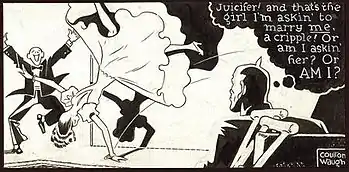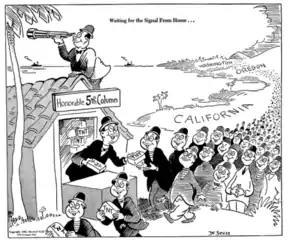PM (newspaper)
PM was a liberal-leaning daily newspaper published in New York City by Ralph Ingersoll from June 1940 to June 1948 and financed by Chicago millionaire Marshall Field III.
| Type | Daily |
|---|---|
| Founder(s) | Ralph Ingersoll |
| Founded | June 1940 |
| Political alignment | Liberal |
| Ceased publication | June 1948 |
| Headquarters | New York City |
| Circulation | 165,000 |
The paper borrowed many elements from weekly news magazines, such as many large photos and at first was bound with staples. In an attempt to be free of pressure from business interests, it did not accept advertising. These departures from the norms of newspaper publishing created excitement in the industry. Some 11,000 people applied for the 150 jobs available when the publication first hired staff.
Publication history

The origin of the name is unknown, although Ingersoll recalled that it probably referred to the fact that the paper appeared Post Meridian (in the afternoon);[2] The New Yorker reported that the name had been suggested by Lillian Hellman.[3] (There is no historical evidence for the suggestion that the name was an abbreviation of Picture Magazine.)
The first year of the paper was a general success, though it was already in some financial trouble: its circulation of 100,000–200,000 was insufficient. Circulation averaged 165,000, but the paper never managed to sell the 225,000 copies a day it needed to break even. Marshall Field III had become the paper's funder; quite unusually, he was a "silent partner" in this continually money-losing undertaking.[4]
According to a June 21, 1966, memo from Ingersoll:
Before the end of the War it was actually operating in the black.... In my opinion at the time and these 20 years later−PM's death is most soundly attributable to a sustained and well-organized plot originating amongst Field's friends and associates in the business world who were alienated by Field's loyalty to PM and to me. The hostility was there from the beginning; the plot came together under the auspices of a man named Harry Cushing who was a retainer of Field's. The principal and successful offensive of this group was that it had as its objective Field's distraction from PM by persuading him to start the Sun in Chicago. Once they committed Field to the Sun venture, the end was inevitable. I can diagram it for you but merely put it on record here.[5]
PM was sold in 1948 and published its final issue on June 22. The next day it was replaced by the New York Star, which folded on January 28, 1949.
Politics

There were accusations that the paper was Communist-dominated, but others have concluded that the paper frequently opposed the policies of the Communist Party (CP) and engaged into editorial battles with the CP's paper, the Daily Worker.[6]
Staff
Editors
Leo Huberman was labor editor.
Writers
I. F. Stone was the paper's Washington correspondent. He published an award-winning series on European Jewish refugees attempting to run the British blockade to reach Palestine (later collected and published as Underground to Palestine). Staffers included theater critic Louis Kronenberger and film critic Cecelia Ager.
The sports writers were Tom Meany, Tom O’Reilly and George F. T. Ryall, who covered horse racing. Sophie Smoliar was the New York City reporter working frequently with photographer Arthur Felig (Weegie) (submitted by her son and a collection of her original articles). Elizabeth Hawes wrote about fashion, and her sister Charlotte Adams covered food.[4][7]
Contributors
Theodor Geisel, better known as Dr. Seuss, published more than 400 cartoons on PM's editorial page.[7][8] Crockett Johnson's comic strip Barnaby debuted in the paper in 1942. Other artists who worked at PM included Ad Reinhardt, one of the founders of Abstract Expressionism, and Joseph LeBoit, who both contributed margin cartoons and drawings. Noted artist Jack Coggins contributed wartime artwork for at least 9 issues between 1940 and 1942.[9]
Coulton Waugh created his short-lived strip, Hank, which began April 30, 1945 in PM. The story of a disabled G.I. returning to civilian life, Hank had a unique look due to Waugh's decorative art style, combined with dialogue lettered in upper and lower case rather than the accepted convention of all uppercase lettering in balloons and captions. Some dialogue was displayed with white lettering reversed into black balloons. Hank sought to raise questions about the reasons for war, and how it might be prevented by the next generation. Waugh discontinued it at the very end of 1945 because of eyestrain.[1] Cartoonist Jack Sparling created the short-lived comic strip Claire Voyant, which ran from 1943 to 1948 in PM, and which was subsequently syndicated by the Chicago Sun-Times.
Other writers who contributed articles included Erskine Caldwell, Myril Axlerod, McGeorge Bundy, Saul K. Padover, James Wechsler, eventually the paper's editorial writer, Penn Kimball, later a professor at the Columbia University Graduate School of Journalism, Myril Axelrod Bennett, Heywood Hale Broun, James Thurber, Dorothy Parker, Ernest Hemingway, Eugene Lyons, Earl Conrad, Benjamin Stolberg, Louis Adamic, Malcolm Cowley,[4] Tip O'Neill (later Speaker of the House;[7] and Ben Hecht.[4]
Photographers
Weegee, Margaret Bourke-White, Ray Platnick and Arthur Leipzig were the primary photographers.
- Julius "Skippy" Adelman (born around 1924)[10][11]
- John Albert (né John Joseph Albert; 1910–1972)
- Bernie Aumuller (né Bernard A. Aumuller; 1920–1971), his father, Bernard George Aumuller (1895–1975) was also a photographer
- Gene Badger
- Margaret Bourke-White (1904–1971)
- Hugh Broderick (né Hugh J. Broderick; 1910–1971)
- William "Bill" Brunk (Los Angeles Examiner)
- John S. DeBiase (1901–1954)[12]
- John Derry
- Stephen Derry
- David Eisendrath, Jr. (né David Benjamin Eisendrath; 1914–1988)
- Morris Engel (1918–2005)
- Alan Fischer
- Morris Gordon (1918–2005)
- Irving Haberman (né Isaac Haberman; 1916–2003)
- Martin Harris (1908–1971)
- Dan Israel
- Charles Fenno Jacobs (1904–1974)
- Dan Keleher, (né Daniel J. Keleher, Jr., 1908–1952)
- Peter Killian
- Arthur Leipzig (né Isidore Leipzig; 1918–2014)[13]
- Helen Levitt (1913–2009)
- Leo Lieb (né Morris Leo Lieb; 1909–2001)
- Ray Platnick (né Raphael Platnick; 1917–1986)
- Weegee, (pseudonym of Arthur (Usher) Fellig (1899–1968)[14]
- Mary "Morrie" Morris (né Mary Louise Morris; 1914–2009), one of the first female AP photographers and pioneer of white umbrellas used give a softer look to flash lighting and portraiture. She, in June 1937, married filmmaker Ralph Steiner. In 1963, she married classical record producer for Mercury, Harold Lawrence (né Harold Levine; 1923–2011), who, at the time, was the General Manager of the London Symphony Orchestra
Contributing photographers
- Robert Capa (1913–1954)
- Walker Evans (1903–1975)
- Edward Weston (1886–1958)
- Edward Steichen (1879–1973)
- Ralph Steiner (1899–1986)
Sunday magazine section
Picture News was the Sunday magazine section of PM.
- Editor: William Thomas McCleery (1912–2000)
- Managing editor: Herbert Yahraes (né Herbert Conrad Yahraes, Jr.; 1906–1985)
- Associate editors: Lorimer Dexter Heywood (1899–1977), Kenneth Stewart, David Rodman Lindsay (1916–1985), Peggy Wright, Gertrude Stamm
- Staff: Raymond Abrashkin (1911–1960), Skippy Adelman, Holly Beye (née Helen Beye; 1922–2011), W. Russell Bowie, Jr. (1920–2002) (son of Walter Russell Bowie), Mary Morris (maiden; 1914–2009), Charles Norman (1904–1996), Roger Samuel Pippett (1895–1962), Robert Rice (1916–1998), Selma Robinson (maiden; 1899–1977) (mother-in-law of Hymen B. Mintz), Dale Rooks (né Rhine Dale Rooks; 1917–1954) (photographer), Lillian E. Ross (née Lillian Rosovsky; 1918–2017)
- Art director: H. Russell Countryman
See also
Bibliography
References
- Waugh, Coulton. The Comics. New York: Luna Press, 1974 (original copyright 1947).
- Hoopes, Roy. Ralph Ingersoll: A Biography. New York: Atheneum (1985), p. 216; OCLC 1088214949
- "Notes & Comment: Newspaper". The New Yorker: 13–14. 18 May 1940.
- Starr, Roger (1918–2001), "PM: New York's Highbrow Tabloid," City Journal, Summer 1993. Accessed online January 24, 2018.
- Ingersoll to Mrs. Leighner, Boston University Gottlieb Archives
- "We Are Against People who Push Other People Around: A Study of the Newspaper PM" (B.A. thesis), by Anya Schiffrin, Reed College (1984); OCLC 268862072
- Nel, Philip, PhD (née Webb; born 1969). "About the Newspaper PM". The Crockett Johnson Homepage. Retrieved June 21, 2005.
- "Serious Seuss: Children's author as political cartoonist". CNN.com. October 17, 1999.
- "Jack Coggins - Newspaper PM Illustrations". January 13, 2018.
- "Jazz Pix: Skippy Adelman's Pictures Have the Spontaniety That is the Very Soul of Jazz," Popular Photography, Vol. 18, No. 6, June 1946, p. 54
- "The Hardboiled School of Photography: The Legend of Skip Adelman, PM's Picture Ace," Minicam Photography, Vol. 8, April 1945, pps. 30, 33, 80, 82
- "John S. DeBiase, New York Daily News, May 18, 1954, p. 27C (accessible via Newspapers.com, subscription required)
- "Interviews with ASMP Founder: Arthur Leipzig" (re: Arthur Leipzig), interview and transcript by Kay Reese & Mimi Leipzig, American Society of Media Photographers (© 1966)ASMP staff edited the transcript for online presentation and added supplemental biographic information.
- "Tabloid, Inc.: Crimes, Newspapers, Narratives," by V. Penelope Pelizzon and Nancy M. West, Theory and Interpretation of Narrative, Ohio State University Press (2010)
External links
- Fulton History newspaper archive for PM
- Morris Engel Archive
- Old Magazine Articles
- Kansas State University
- Dr. Seuss Went to War